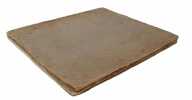"CHLADNI, ERNST FLORENS FRIEDRICH.
Entdeckungen über die Theorie des Klanges. - [INAUGURATING THE FIELD OF ACOUSTICS]
Leipzig, Weidmanns Erben und Reich, 1787. 4to. Uncut in the original interrim boards. Small exlibris-stamp (J. L. Prevost) to front free end-paper. Light brownspotting throughout. An excellent unsophisticated copy. (4), 77, (1) pp + 11 plates (by S. Capieux).
Reference : 60253
First edition of Chladni’s landmark work on the production of sounds from solid bodies, inaugurating the field of acoustics. Here, he demonstrated the method by sprinkling sand on plates of glass or metal and drawing a bow down their sides to produce a visible vibration pattern called ""Chladni figures” or “Chladni patterns”. ""The production of sound from solid bodies was not clearly understood until Chladni devised the method of sand figures to illustrate the structure of vibrations in a solid body"" (Norman). Chladni ""was the first to reduce the general association between vibration and pitch to a tabular basis and thus to lay the foundation of the modern science of acoustics"" (PMM). In his famous 1787-experiment, Chladni drew a bow over a piece of centrally fixed metal plate covered with sand, and the vibration of the plate caused the sand to move and accumulate around the nodal lines where the surface remained still, forming Chladni figures. The experiments by Chladni are a corner stone of modern acoustics. However, the motion of particles before they settle to the nodal lines is still not very well understood, and only hypothetical models have been put forward. Chladni had visited the Paris Academy in 1808 and had demonstrated the vibration patterns before an audience that included not only the leading French scientists but Napoleon himself"" Napoleon set a prize for the best mathematical explanation but no satisfactory explanations came out of it. Napoleon famously remarked ""Chaldni mhas made sound visible"" (Dibner). Variations of this technique are still commonly used in the design and construction of acoustic instruments such as violins, guitars, and cellos. Since the 20th century, it has become more common to place a loudspeaker driven by an electronic signal generator over or under the plate to achieve a more accurate adjustable frequency. In quantum mechanics, Chladni figures (""nodal patterns"") are known to be related to the solutions of the Schrödinger equation for one-electron atoms, and the mathematics describing them was used by Erwin Schrödinger to arrive at the understanding of electron orbitals.Dibner 150PMM 233Norman 480Sparrow 39
Bookseller's contact details
Herman H. J. Lynge & Son
William Schneider
Silkegade 11
1113 Copenhagen
Denmark
+45 33 155 335
Payment mode
Sale conditions
All items may be returned for a full refund for any reason within 14 days of receipt.
 Write to the booksellers
Write to the booksellers






